A History of the Future: Imagining Melbourne
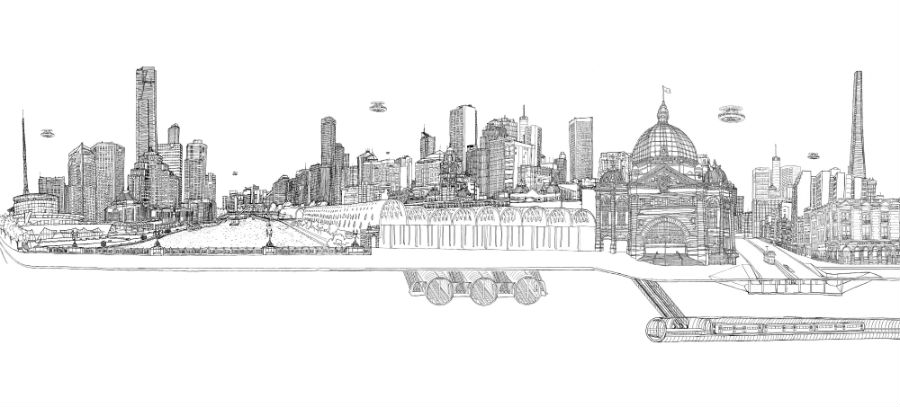
The Future Melbourne 2026 project asked Melburnians to consider their city for the decade ahead. So what better time to reflect on the kinds of futures that were imagined for Melbourne in the past. Some big dreams and ambitious visions have been realised, others have not – for better or for worse. And it’s not just the appearance of the city that these imaginings have shaped, but also how we interact with it, move through it and inhabit it.
The exhibition A History of the Future: Imagining Melbourne looks back in order to look forward. For 180 years, city planners, architects, artists and writers have imagined a future Melbourne from the vantage point of their own time and place. The stories told here provide just a snapshot of the many plans, schemes and dreams that have been variously realised or shelved as Melbourne has considered its future self. They reveal changes in attitudes – towards heritage, the natural environment and modernity – that have shaped much of the city that we find ourselves in today.
The exhibition also includes a 14-metre-long wall drawing by artist Lewis Brownlie, which imagines a Melbourne skyline that might have been if these various proposals had gone ahead.
The following are a number of examples featured in the exhibition.
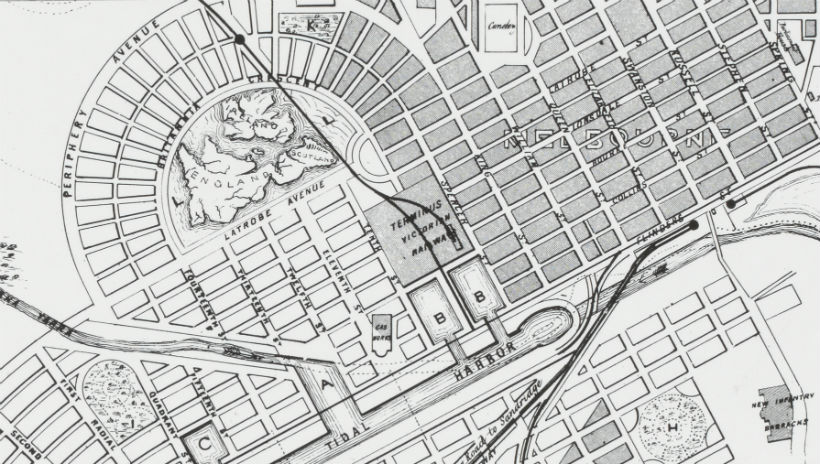
Design for Ship Canal or ‘Tidal Harbor’ and Docks for the Port of Melbourne with Proposed Extension of the City West-ward (detail), 1860, drawn by John Millar, State Library Victoria

Proposed Redevelopment of the Queen Victoria Market Site, c. 1970s, City of Melbourne Art and Heritage Collection
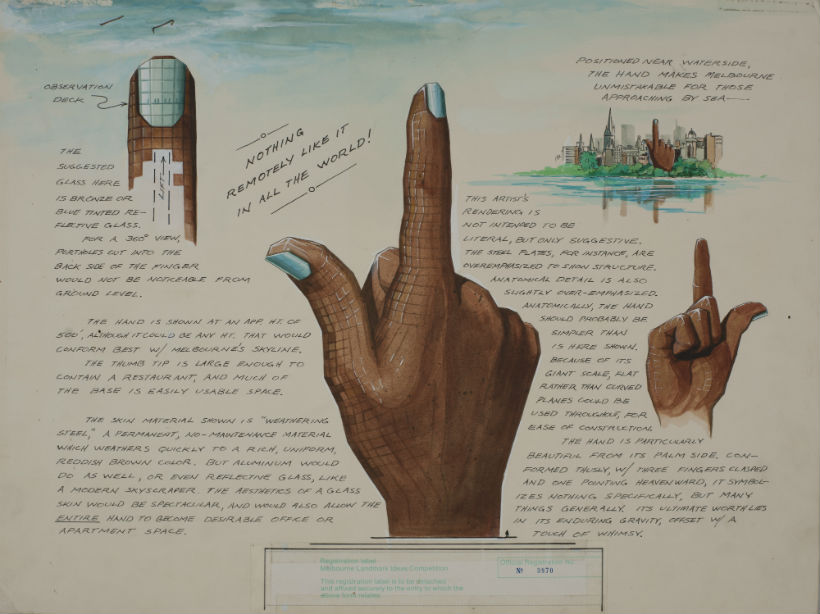
Hand-shaped building, 1978, designed by Michael Hilton, Decatur, Texas, USA, Public Record Office Victoria

Peak Hour, 1970, illustration by C.F. Beauvais, the Argus Weekend Magazine, 28 August 1943, State Library Victoria
The following text accompanied this image when published in 1943:
‘PEAK HOUR, 1970’ is the fanciful title given to this drawing by C.F. Beauvais ... He imagines that Melbourne has been rebuilt and that this particular scene is on the roof of The Argus building, at the corner of Elizabeth and Latrobe sts. The big helicopter in the foreground is just landing, brought to its exact landing place by a beam of light. On the roof are cafes and roof gardens, with elevators leading to ground level and garage accommodation beneath the surface. Giant pancake autogiro buses, capable of carrying dozens of passengers in a circular compartment, can take off and land vertically. While they are in the air – and there are hundreds of them in the air during ‘peak hour’ – automatic devices prevent them from colliding or getting in each other’s way.
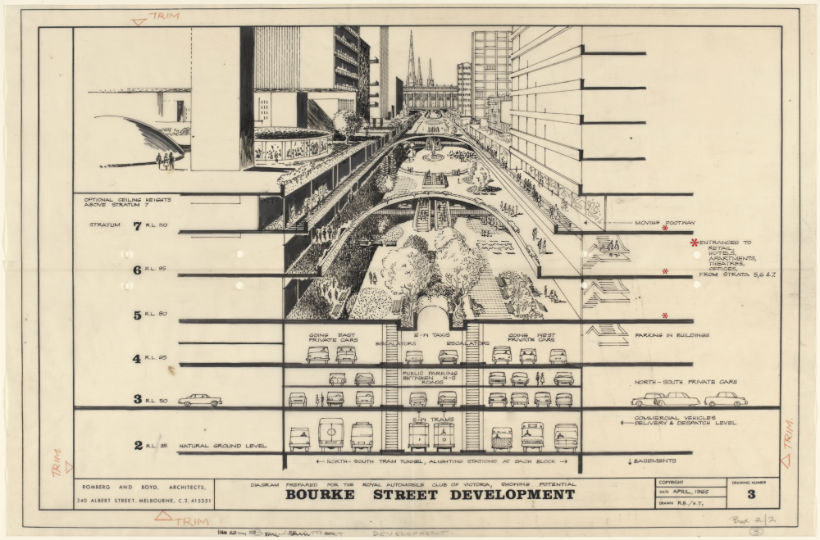
Robin Boyd (Romberg and Boyd), Bourke Street Development, 1965, State Library Victoria, courtesy of Robin Boyd Foundation and Diane Masters
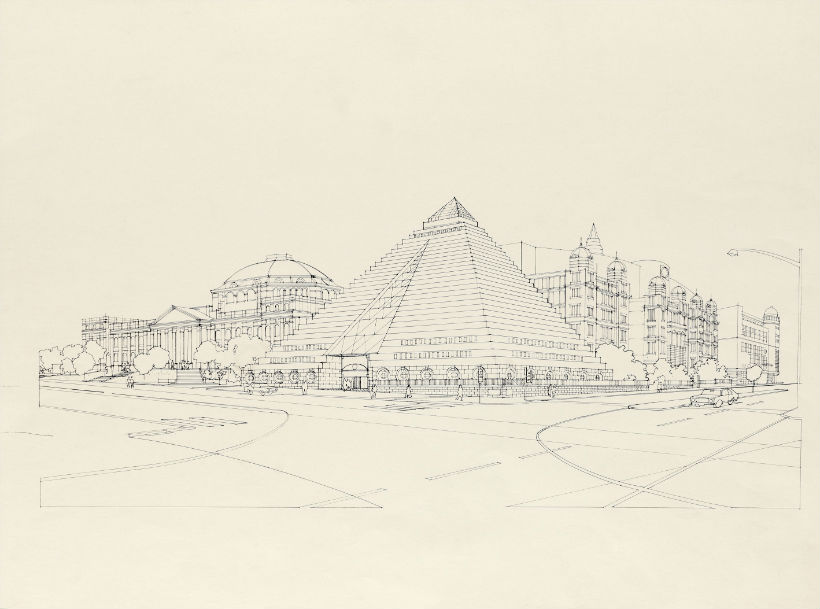
Peter Corrigan, architect (Edmond and Corrigan)
Design for the Victorian State Library and Museum Architectural Competition, 1985
Courtesy of Edmond and Corrigan Pty Ltd

Robert Suggett, Lawn at Dawn, 1985, City of Melbourne Art and Heritage Collection, courtesy of the artist
John Wardle Architects and Stefano Boscutti with FloodSlicer
Multiplicity, 2010
Produced for NOW and WHEN: Australian Urbanism, 2010 Venice Architecture Biennale, organised by the Australian Institute of Architects

Multiplicity is one of 17 works created for the Australian pavilion of the 2010 Venice Architecture Biennale, the brief for which was to imagine an Australian city of the future. The creators have written of Multiplicity:
By 2110 new planning initiatives in Melbourne incubate a self-sustaining urban environment of hyper-density. Conventional dividing lines of wealth, privilege, and ethnicity are increasingly blurred. Technology has diffused the civic institution and further concentrated the private realm. Growth has not been at the periphery but from the heart. Melbourne has not grown out but up and down ... A datum high above has created multiple ground planes and urban topographies including food production, rain harvesting and energy generation.
A History of the Future: Imagining Melbourne
- Free exhibition
- City Gallery, Melbourne Town Hall, enter via Halftix
- Until 12 August 2016
